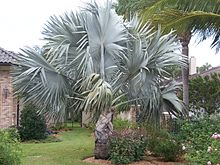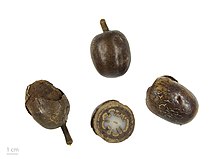Bismarckia
| Bismarckia | |
|---|---|

| |
| Scientific classification | |
| Kingdom: | Plantae |
| Clade: | Tracheophytes |
| Clade: | Angiosperms |
| Clade: | Monocots |
| Clade: | Commelinids |
| Order: | Arecales |
| Family: | Arecaceae |
| Subfamily: | Coryphoideae |
| Tribe: | Borasseae |
| Genus: | Bismarckia Hildebr. & H.Wendl. |
| Species: | B. nobilis
|
| Binomial name | |
| Bismarckia nobilis | |

Bismarckiais amonotypicgenusofflowering plantin thepalmfamilyendemicto western and northernMadagascar,where it grows in opengrassland.
Etymology
[edit]The genus is named for the first chancellor of theGerman EmpireOtto von Bismarckand the epithet for its only species,Bismarckia nobilis,comes fromLatinfor 'noble'.[3]
Description
[edit]
Bismarckia nobilisgrows from solitary trunks, gray to tan in color, which show ringed indentations from old leaf bases. Trunks are 30 to 45 cm in diameter, slightly bulging at the base, and free of leaf bases in all but its youngest parts. In their natural habitat they can reach above 25 meters in height but usually get no taller than 12 m in cultivation. The nearly roundedleavesare enormous in maturity, over 3 m wide, and are divided to a third its length into 20 or more stiff, once-folded segments, themselves split on the ends. The leaves are induplicate and costapalmate, producing a wedge-shaped hastula where the blade andpetiolemeet. Petioles are 2–3 m, slightly armed, and are covered in a white wax as well as cinnamon-colored caducous scales; the nearly-spherical leaf crown is 7.5 m wide and 6 m tall. Most cultivatedBismarckiasfeature silver-blue foliage although a green leaf variety exists (which is less hardy to cold).[3]These palms aredioeciousand produce pendent, interfoliarinflorescencesof small brownflowerswhich, in female plants, mature to a brown ovoiddrupe,each containing a singleseed.
Distribution and habitat
[edit]Native to Madagascar, anislandwell known for its rich diversity of unique taxa,Bismarckiais one genus among a diverse palm flora (some 170 palms of which 165 are solely in Madagascar).[4]They grow in the plains of thecentral highlands,nearly reaching the western and northern coasts, in savannas of low grass, usually inlateriticsoil. As much of this land has been cleared with fire for agricultural use,Bismarckias,along with other fire-resistant trees likeRavenala madagascariensisandUapaca bojeri,are the most conspicuous components of this arid region.[5]
Cultivation
[edit]Bismarck palms are grown throughout thetropicsandsubtropicsunder favorablemicroclimates.They are grown in many parts ofIndonesia,Australia,as well as in landscaping in theUnited Arab Emirates.In theUnited States,they are planted in several areas ofFlorida,a few areas ofSouthern California,southern and southeasternTexas,and southernArizona.[6]Bismarck palms will suffer from cold damage but they quickly recover. The green variety is more cold sensitive than is the silver-gray variety. The green variety is damaged at 0 °C (32 °F), but the silver-gray variety will tolerate −3 °C (27 °F) and will recover from −6 °C (21 °F).[citation needed]WhileBismarckiatolerate some drought, they thrive in areas with adequate rainfall. Because of their massive crowns, they need plenty of room in a landscape area.
Bismarck palm tree care and maintenance
[edit]This articleis written likea manual or guide.(June 2017) |
Bismarck palms are easy to grow in the right environment as they are adaptable to a wide range of soils and prefer to have good drainage as the Bismarck does not like to have root rot. The Bismarck palm can adapt to either acidic or alkaline soil and prefers to be watered directly into the root system or sprayed through the palm heart. When planting the Bismarck palm make sure to not to cover up any part of the trunk, as this will lead to problems as the Bismarck palm is susceptible to be eaten by microorganisms that live naturally in soil and other mediums.[6]
References
[edit]- ^Rakotoarinivo, M. & Dransfield, J. 2012.Bismarckia nobilis.The IUCN Red List of Threatened Species 2012: e.T195991A2440090.https://dx.doi.org/10.2305/IUCN.UK.2012.RLTS.T195991A2440090.en.Accessed on 05 May 2023.
- ^Hildebrant and H. A. Wendland,Botanische Zeitung39:90, 93. 1881. Type:B. nobilis
- ^abRiffle, Robert L. and Craft, Paul (2003)An Encyclopedia of Cultivated Palms.Portland: Timber Press.ISBN0-88192-558-6/ISBN978-0-88192-558-6(Page 274)
- ^"Flora in Madagascar".Archived fromthe originalon 2009-02-24.Retrieved2008-02-27.
- ^"Ecoregions of Madagascar".Terrestrial Ecoregions.World Wildlife Fund.
- ^abhttp://realpalmtrees.com/palm-blog/a-e/bismarck-palm-bismarckia-nobilis/Bismarck palm blog


